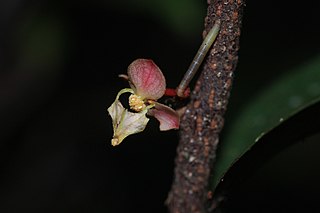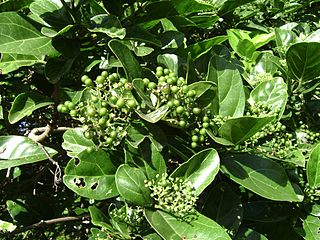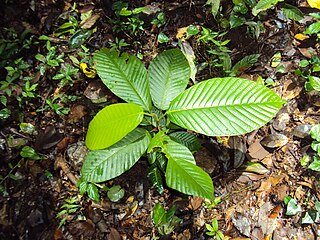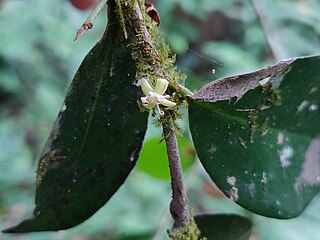
Orophea thomsonii or Thomson's Turret Flower is a species of shrub or small tree in the Annonaceae family. It is native to Kerala and Tamil Nadu in India and endemic to the Western Ghats mountain range.

Palaquium ravii is a species of tree in the family Sapotaceae. It is endemic to the Western Ghats mountains and native to Kerala and Tamil Nadu in India.

Vateria indica, the white dammar, is a species of tree in the family Dipterocarpaceae. It is endemic to the Western Ghats mountains in India. It is threatened by habitat loss. It is a large canopy or emergent tree frequent in tropical wet evergreen forests of the low and mid-elevations.

Vatica chinensis is a species of flowering tree in the family Dipterocarpaceae, found in South Asia.

The Geography of South India comprises the diverse topological and climatic patterns of South India. South India is a peninsula in the shape of a vast inverted triangle, bounded on the west by the Arabian Sea, on the east by the Bay of Bengal and on the north by the Vindhya and Satpura ranges.

Kattungal Subramaniam Manilal is an Emeritus of the University of Calicut, a botany scholar and taxonomist, who devoted over 35 years of his life to research, translation and annotation work of the Latin botanical treatise Hortus Malabaricus. This epic effort brought to light the main contents of the book, a wealth of botanical information on Malabar that had largely remained inaccessible to English-speaking scholars, because the entire text was in the Latin language.

Social Democratic Party of India, popularly known as SDPI, is an Indian political party founded on 21 June 2009 in New Delhi. It is regarded as the political wing of the banned Islamic organization, Popular Front of India (PFI). It was registered with the Election Commission of India on 13 April 2010. M. K. Faizy is the party's National President.

Premna serratifolia is a small tree/shrub in the family Lamiaceae. It flowers and fruits between May and November. During flowering season, it attracts a large number of butterflies and bees. Synonyms of Premna serratifolia Linn. include P. corymbosa Merr., P. integrifolia L. and P. obtusifolia R. Br.).
This article gives a list of the territories of the dioceses of the Catholic Church in India.
Diospyros atrata is a tree in the Ebony family. It commonly grows to 25 metres tall. The plant can be seen in subcanopy trees in medium elevation wet evergreen forests between 1000 and 1400 m in Western Ghats- South Sahyadri, Kerala, and Tamil Nadu in India and from Kandy district in Sri Lanka

Jasminum malabaricum, the Malabar jasmine or wild jasmine, is a species of flowering plant in the family Oleaceae, native to southern parts of India, and Sri Lanka.

Garcinia pushpangadaniana is a tree species in the family Clusiaceae. It was described in 2013 from a population found in the southern part of the Western Ghats in India. The specific epithet of this species honors Dr. P. Pushpangadan, former Director of Jawaharlal Nehru Tropical Botanical Garden & Research Institute.

Dipterocarpus bourdillonii is a species of large tree in the family Dipterocarpaceae endemic to the Western Ghats principally in the state of Kerala in India. It is a Critically Endangered species according to the IUCN Red List of Threatened Species. It is a characteristic tree of the low-elevation tropical wet evergreen rainforests in the Western Ghats.
National Highway 66, commonly referred to as NH 66, is a 4 lane 1,608 km (999 mi) long busy National Highway that runs roughly north–south along the western coast of India, parallel to the Western Ghats. It connects Panvel to Cape Comorin (Kanyakumari), passing through the states of Maharashtra, Goa, Karnataka, Kerala and Tamil Nadu.

''Ficus cyathistipula'', the African fig tree, is a species of fig that is native to the tropical forest regions of Africa. They may be small trees, shrubs or hemi-epiphytic lianas, and are widespread in the moist tropics, where they may be found in Afromontane or rainforest, often overhanging pools. The figs are reddish when ripe, and have thick, spongy walls that enable them to float on water. They are named for their cup-shaped (cyathus-) and persistent stipules (stipula).

Clematis gouriana, or Indian Traveller's Joy, is a liana found in Asia which belongs to the buttercup family (Ranunculaceae). It was described by Roxb. ex DC. and published in Regni Vegetabilis Systema Naturale 1: 138-139, in 1818.

Ficus amplissima, also known as the Indian Bat tree, Indian Bat fig, Pimpri, Pipri (Piparee), Pipali or Bilibasari mara is a tree species of flowering plants that belongs to Moraceae, the fig or mulberry family. It is native to Central and southern Peninsular India, Sri Lanka and Maldives, having a significant distribution throughout Western Ghats of India. It is most commonly planted to provide shade in coffee plantations due to its dense and wide foliage. The ripened figs attract many birds, especially during the spring.

Casearia graveolens is a species of tree in the family Salicaceae, native to an area in Asia from Thailand to South Central China to Pakistan. The plant is used in fishing, fuel, medicine, as a source of non-edible oil, in construction and as food.

Diospyros paniculata, or the panicle-flowered ebony, is a species of tree in the ebony family. Endemic to the Western Ghats area of India and parts of Bangladesh, the species is currently listed as Vulnerable in the IUCN Red List.

Drypetes wightii is an evergreen tree species endemic to the Western Ghats, India. The species is considered Vulnerable under the IUCN Redlist of Threatened Species.





















